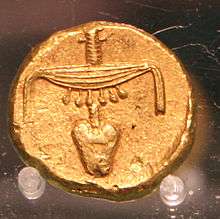Egyptian gold stater
The gold stater (Egyptian: nfr-nb, "Nefer-nub", meaning "fine gold") was the first coin ever minted in ancient Egypt, around 360 BCE during the reign of pharaoh Teos of the 30th Dynasty.

Gold stater of Nectanebo II: reverse with hieroglyphs nfr-nb
Under Teos
Teos introduced the gold stater in order to pay salaries of Greek mercenaries who were at his service.
- Gold stater with the same weight of a Persian daric (around 8.42 grams), with an owl on the left, modelled after the Athenian model, and a papyrus on the right.
- Gold stater as a tetradrachm, with an owl on the left and an olive branch on the right, with the Demotic writing "Teos... Pharaoh".
Under Nectanebo II
Teos' successor Nectanebo II kept this practice, though coining his personal gold staters.
- Gold stater as a daric (about 8.42 grams), obverse with a prancing horse on the right,[1] reverse with the hieroglyphs nfr-nb.
- Small gold stater (about 2.56 grams, diameter 14-15mm), with a probable picture of a leaping gazelle. Its attribution to Nectanebo II, however, is not confirmed.
gollark: What are you compilinininiating?
gollark: What?
gollark: 5788.999999999999999999999999999999, why?
gollark: Oh good, I was worried I would have to orbital-lase you AGAIN!
gollark: Cool.
See also
Sources
- Schulz, Seidel, 1998. Egypt: The World of the Pharaohs, Editors, Regine Schulz, Matthias Seidel, Konemann Verlagsgesellschaft mbH, Cologne, English translation version. p. 370. (obverse, reverse) (hardcover, ISBN 3-89508-913-3)
- Ernst Gölitzer, Entstehung und Entwicklung des alexandrinischen Münzwesens von 30 v. Chr. bis zum Ende der julisch-claudischen Dynastie. Akademie-Verlag, Berlin 2004, ISBN 3-05-004089-0, p. 6.
This article is issued from Wikipedia. The text is licensed under Creative Commons - Attribution - Sharealike. Additional terms may apply for the media files.